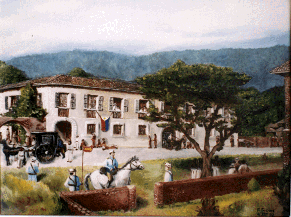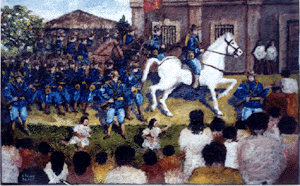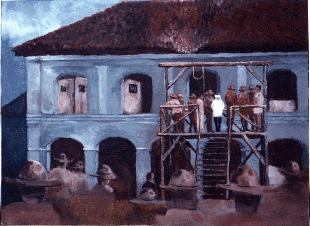by Ramon Sison
© 1996 by Ramon Sison and PHGLA
All rights reserved
http://www.bibingka.com/phg/cabugao/default.htm
United States Commodore George Dewey landed in Manila on May 1, 1898. He was followed shortly by Gen. Emilio Aguinaldo who came back from Hong Kong on May 19 and by Brig. Gen. Manuel Tinio the following month. On August 13, Tinio led his troops from Nueva Ecija to liberate Vigan. He arrived too late, however, and was greeted there by the llocos regional commanders, Col. Blas Villamor and Col. Juan Villamor, cousins from Bangued, Abra. The Spaniards had already surrendered to the llocanos.
The Town of Cabugao
At the house of Capitan Don Leandro Solosa y Serrano in Cabugao, hundreds of Spanish cazadores (infantrymen) were being held prisoners while waiting transport to join 3,000 other prisoners in Vigan. A few of them chose not to be repatriated and elected to stay in Cabugao. They worked as household servants of wealthy dons. One of them was Señor Alvero who served as yaya (babysitter) for a boy who would later become the first physician of the town. Decades later after he had married and settled in Sinait, Alvero still addressed Dr. Teodoro Sison, Among Doro (llocano for Sir or Master Doro).

Ilocos was again free of foreign domination for the first time in the 136 years since Diego Silang took over for a brief period. A new independent government was formed in Candon. Under the new government, the old gobernadorcillo or alcalde was given the new title of presidente municipal. The incumbent and last alcalde, Don Gorgonio Sison y Suller, continued his term as first presidente municipal the last three-and-a-half months of 1898. He was succeeded in January 1899 by Don Basilio Noriega, who was first to be elected presidente municipal by the principalia. The principalia, consisting of the capitanes of more than twenty barangays continued to enjoy the old privileges of the landed gentry, including the exclusive right to vote. Members of the principalia were also the only ones qualified to run for office.
American Aggression
On December 10, 1898 under the Treaty of Paris, the Philippines– already a liberated, self-governing, independent nation since September 15, 1898– was purchased by the United States of America from Spain for twenty million dollars. With the Philippine population then at ten million, the price comes out to two dollars per head. United States President William McKinley, his “manifest destiny” and his fellow Republican imperialists succeeded in getting the treaty ratified by Congress. The Philippine-American War began “accidentally” in the darkness of the night of February 4, 1899, in San Juan del Monte, while the Americans awaiting orders held Manila under siege. The Americans were determined to get the “Brooklyn Bridge” they were sold. McKinley won the Philippine debate against the silver-tongued orator, William Jennings Bryan, the 1900 presidential election, and finally the Filipino-American War in 1901.
The Philippines became the first colony of the new American empire. McKinley claimed that he found the Philippines on a world map, went down on his knees, talked to God, and that by divine inspiration he felt compelled to civilize and Christianize his “little brown brothers” by offering them “benevolent assimilation.” Rudyard Kipling condescendingly called that task the “white man’s burden.” The American president, however, was ignorant of the fact that the Philippines was already a 333-year-old Europeanized Catholic country.
By April 1899, 640 defensive trenches were built from La Union to Ilocos Norte. They were designed by Gen. Jose “Pepe” Alejandrino, a Belgian-educated engineer from Pampanga. The Salomague coastal trenches built by Cabugao reserves were described by two American reporters, Sargent and Wilcox, as follows: “On the shore at Salomague, there is a fortification about five feet high and one hundred fifty feet long. This barricade is built of sticks arranged in two rows and filled in between with sand and coral stones. Its walls are about four feet thick, and it is built in the form of a crescent with the concave part toward the sea…”
First American Invasion
The American invasion of Ilocos finally came but no landing was attempted at the Salomague port of Cabugao. On November 26, 1899, the warships U.S.S. Oregon, U.S.S. Samar, and U.S.S. Callao bombarded Caoayan and, unopposed, landed 201 blue-jacketed United States volunteer infantrymen and marines led by Lt. Col. James Parker. The llocanos of Vigan joyfully welcomed the Americans not for political reasons, but probably as an emotional demonstration of relief after suffering abuses in the hands of Tinio’s Tagalog soldiers.

Three days later, on November 29, Tinio was about twenty kilometers south of Vigan at Tangadan Pass providing security for Aguinaldo’s passage through Abra. Not too far south of Tinio was Tirad Pass, where Brig. Gen. Gregorio del Pilar, on the same mission, was killed a few days later on December 2. Parker proceeded north from Vigan past Cabugao and reached Batac, Ilocos Norte on December 7. The U.S.S. Wheeling landed more marines and army troops farther north in Laoag and Bangui on December 10. On December 17, United States troops captured the Cabugao and Sinait trenches and had Tinio’s men, under Capt. Francisco Celedonio, on the run.
In the middle of the night on December 20, an unhappy Celedonio sneaked back into Cabugao with a commando unit, abducted and bayoneted to death Presidente Municipal Basilio Noriega and his son-in-law, Don Benigno Sison y Suller, an innocent bystander. Noriega had been falsely accused as being a pro-American sajonista (Saxonist or pro-Anglo-Saxon). He was in fact condemned without trial by tiktiks (informers) who held personal grudges against him. His son-in-law unfortunately happened to be there and was a witness to the kaut (abduction). Their bodies were found the following morning in the wooded area north of the church, each marked on the forehead “traidor de la patria” (traitor to the country). Ironically, Don Benigno’s family of Sisons and Sullers and their Azcueta-Serrano wives and in-laws were the wealthiest and biggest contributors to the revolutionary movement in Cabugao.
Aguinaldo’s Escape
On January 14, 1900, Tinio and his men valiantly fought the Battle of Monte Bimmuaya southeast of Cabugao against the Thirty-Third United States Volunteer Infantry and the United States Third Cavalry (unit of George Tossi Barbers and James Wingo, Sr., both of whom will be mentioned again later). Elements of this same Thirty-Third infantry unit had killed del Pilar earlier on December 2, 1899, at Tirad Pass, southeast of Candon, llocos Sur, with the help of the Tingguian mercenary Januario Galut. The Battle of Monte Bimmuaya diverted and delayed United States troops from their chase of President Aguinaldo as the latter escaped through Abra and the mountain provinces. After the two-day battle, 28 unidentified martyrs of Cabugao were found buried in unmarked fresh graves in the camposanto (cemetery).
On January 15, 1900, American troop strength in Cabugao was increased from less than 200 to 1,000. Each town normally had 50 to 200 garrison troops. This was because for the past seven weeks, the Cabugao garrison had been attacked regularly every Sunday.
Beginning January 23, bolomen saboteurs cut telegraph lines every night north and south of town. On September 2, two men caught in the act of cutting lines were tortured and killed. The Americans terrorized the population by numbering every telegraph pole and assigning responsibility of keeping lines intact to the residents of each designated sector. Houses were burned and men were imprisoned, tortured with the dreaded “water cure,” and sometimes even killed in retaliation for the cutting of lines in their designated areas.
Other War Events of 1900
In the year 1900, many other war-related events took place in Cabugao. On March 5, American patrols routed two Filipino detachments. One Filipino was killed while cutting a line north of town.
On April 6, six Filipinos were killed as they attacked an enemy convoy between Cabugao and Lapog.
On April 12, Gen. Samuel B. Young asked Manila for more reinforcements. The Battle of Cadanglaan took place between Sinait and Cabugao. Col. Blas Villamor was wounded and became disabled until the end of the war. Tinio escaped.
On May 22, the United States military government ordered registration of all male residents of each poblacion and each barrio to enable monitoring of their movements and prolonged absences.
On May 31, an angry Col. Juan Villamor posted notices on the telegraph poles announcing that he was going to destroy all the telegraph lines.
On June 17, Tinio’s headquarters in barrio Maradodon was raided. The Americans captured supplies, documents, and 12,000 rounds of ammunition.
On June 21, some of the American soldiers defected and joined the Filipinos. Among the deserters were Privates John Wagner, Edward Walpole, Harry Dennis, John Allance, and a certain Private Meeks. These men apparently felt outraged by the inhumane treatment of the Filipinos by their fellow Americans.
On July 18, four ponies were captured by the Americans east of the town with the personal papers of Capt. Galicano “Caning” Calve, guerilla unit commander of the northern Ilocos Sur region.
On September 9, the American paymaster and his escorts were ambushed near Cabugao. One American was killed and two others were missing in action.
On September 25, reinforcements consisting of several hundred men of the United States Fifth Infantry Regiment, Third Batallion, landed at Salomague port.
On November 25, another deserter, Private William Hyer, joined the Filipinos. (The story of an American deserter named Private Laurie Macklin, entitled “The Apostate,” is one Philippine-American War story in Trail of Blame, a book written by William Pomeroy and published in 1971. Macklin’s story is a composite of several true incidents of desertion.)
On November 28, orders were received by the Cabugao garrison to seize the rice harvest of Faustino Centeno’s farmlands.
On December 17, Capitan Don Leandro Serrano, wealthy landowner and suspected supporter of the Filipino defenders, was falsely accused of murder. The alleged victims were desaparecidos (people who had disappeared for unknown reasons). His sons– Simeon, Cesareo, and Santiago– were seized and held as hostages until Serrano’s accusers could find false witnesses to testify. Don Leandro and his sons were first jailed in Vigan and later sent into destierro (exile). They were kept prisoners until the end of the war in a dungeon of either Manila’s Fort Santiago or another old Spanish fort in the Marianas Islands. Santiago Serrano said he could not tell where they were because they were transported in total darkness on the ship’s bottom deck. He was unable to count the days, and “all forts and dungeons looked alike,” according to him.
On December 23, Liberato Arcebal, an employee of the Americans, was killed by garrote for “treason” by Filipino guerilleros.
On December 26, the Dingras garrison was ordered to shoot hostage Mariano Pacis (parhaps from Cabugao?) in the public plaza if kidnapped interpreter Dionisio Tali was not delivered safe and sound by nine o’clock in the morning.
Shortly before or during the month of January 1901, Juez de Paz Justo Sonido of Cabugao disappeared. He was probably abducted and killed by the revolucionarios for serving under the American military government. Gorgonio Sison y Suller accepted his appointment as the new municipal judge on January 28, 1901.
On February 8, 1901, the Currimao sailboat San Roque, with owner Feliciano Aurellano and 24 fellow revolucionarios, was captured near Cabugao.
On March 5, 1901, Brig. Gen. J. Franklin Bell arrived in Vigan to replace Brig. Gen. Young as Northern Luzon District Commander.
Hamletting, Scorched Earth, and the End
Six decades before Vietnam, Gen. Young and his successor developed the practice of “hamletting” and “scorched earth policy” in Cabugao and its neighboring towns. Upon the recommendation of Capt. John W. Moore, an officer of the Twenty-Sixth Infantry, and other field officers, Gen. Bell ordered the burning of all rice granaries and rice fields, the evacuation and reconcentration of barrio dwellers, the burning of villages, and the shooting of anything that moved to deprive the Filipino insurrectos of their bases of support and supplies. In the towns of Cabugao, Sinait, and Santo Domingo, 107,520 kilograms of rice were confiscated. Farmers and their families were herded like cattle and reconcentrated in stockades.
On April 21, all inhabitants of Cabugao barrios were given the ultimatum to move into the poblacion within twelve days. On the eleventh day, May 1, 1901, Brig. Gen. Manuel Tinio y Bundok, Northern Luzon Commander of the Filipino Army, and Col. Blas Villamor came out of barrio Maradodon to surrender their troops who were by that time debilitated by illnesses and hunger. They surrendered to Gen. Bell in Sinait more than a month after President Aguinaldo was captured on March 23, 1901.
Prologue
The llocano resistance against American aggression was over. Tinio married his girifriend Laureana Quijano from Sinait, returned to his home province of Nueva Ecija, became Director of the Bureau of Lands, and made the Tinios one of the wealthiest landowning families in the country. He later became provincial governor and he named one Nueva Ecija town Laur, his wife’s nickname.
George Barbers stayed in Cabugao, swore he would never go back to America (and never did), traded his cavalry horse for a motorcycle, went into the transportation business, and married his sweetheart, Silvestra Guerrero.
Barbers’ comrade, James Wingo, Sr., married Silvestra’s sister, Maura Guerrero, had a son named James, Jr., and was recalled by the army to the United States where he died while waiting to return to Cabugao. James, Jr., an Ernie Pyle award-winning war correspondent, revisited his birthplace in 1945. His other son, Walter, became a journalist on the staff of The Washington Post and later became editor of U.S. News and World Report.
On August 30, 1901, Cabugao saw Filipino Army Maj. Francisco Celedonio, the first “war criminal” to be tried and convicted, hanged in the gallows by American soldiers in front of the presidencia, the old municipio. A United States military commission had found Celedonio guilty of the unjustified summary executions of Presidente Municipal Basilio Noriega and his son-in-law Benigno Sison y Suller (Benigno’s infant son, Teodoro Noriega Sison, became the town’s first physician some twenty years later). Don Gorgonio Sison y Suller, Benigno’s brother, was Juez de Paz at the time of Celedonio’s hanging.

Had the Filipinos won the war, Gen. Jacob Smith, who ordered Samar turned into a “howling wilderness,” and Gen. Bell, who was the mastermind of the “first Vietnam,” would have suffered the fate of war criminals. Members of the Federalista Party would also have been hanged as traidores de la patria.
Among the earliest pro-American sajonistas of Ilocos who surrendered to America’s promise of “benevolent assimilation” were Ignacio Villamor, Quintin Paredes, and Mena Crisologo. Their early collaboration with the enemy was well rewarded in the ensuing years of American occupation. After the war, Villamor became the first Filipino president of the University of the Philippines and Supreme Court justice. Paredes became Philippine Resident Commissioner in Washington, D.C. and a senator. Mena Crisologo became governor of Ilocos Sur.
Don Gorgonio Sison, though not a Federalista, was appointed Juez de Paz by the American governor-general in 1901 and became the first mayor elected by popular vote in 1902. Don Gorgonio, during his second term as mayor, prepared a “general collective exhibit” for the 1904 St. Louis (Missouri) Universal Exposition which won a bronze medal for the Municipal Committee of Cabugao. In a matter of time, practically all Filipinos became sajonistas under American military and civilian governor-generals and High Commissioners of the Commonwealth government.
Americanization Complete
Forty years later, the Americanized mom-and-apple-pie Filipinos would fight and die for their colonial masters in the Second World War. By then, the Americanization of the Philippines was complete.